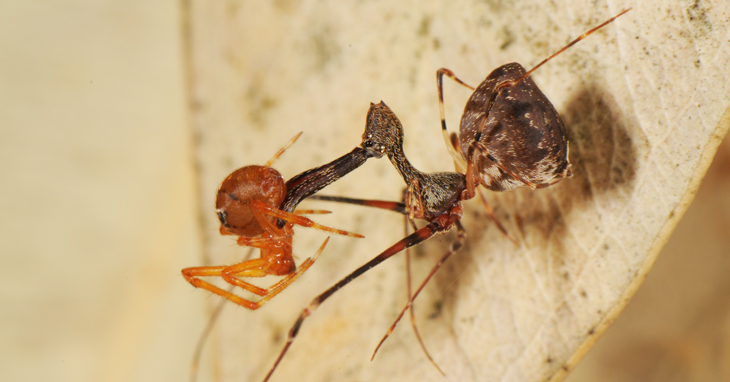
Cannibal spider resembling a pelican discovered in Madagascar
Spiders with a body resembling pelicans have been discovered by researchers in the Madagascar region which were once thought to be extinct. The scientists were able to determine 18 new species of this pelican shaped spiders. Apart from their odd looks, the spiders also behave in an odd fashion. However, despite the out-of-the-ordinary look, the pelican spiders are rather shy in nature. These peculiar species belong to the family Archaeidae which are just as long as the grain of rice. They possess threat, only to other species of spiders.
The first ever specimen obtained was in the year 1854 that was preserved in a piece of amber that dated 50 million years back. Instinctively, the scientists thought that this peculiar species was long lost. However, in the year 1881, living versions of the pelican spiders were discovered near Madagascar that gained much attention pertaining to their peculiar body structure. The pelican spiders range between the lengths of 2 to 8 millimeters with an elongated head that resembles the neck of a pelican with an extended set of jaws.
What makes these spiders different from others is the way they hunt their food. Instead of creating fine webs to catch food, these spiders hunt through the web spun by other spiders by following silk draglines. As they locate the prey, they pluck out the thread from its web while mimicking the vibrations of an insect struggling to escape. As the owner of the web comes to investigate if its web caught any prey, the pelican spider attacks the other spider by the use of his long jaws.
Pelican spiders can usually be seen thriving around the forests of Australia, Madagascar, and South Africa. These areas are mostly uncharted territories which is why they have been unknown for a long time. The Smithsonian’s National Museum of Natural History helped narrow down the features of the pelican spider which was initiated by Hannah Wood, curator of arachnids and myriapods and Nikolaj Schariff, an entomologist from the University of Copenhagen.
After an analysis of hundreds of specimens, the team boiled down the specimens into 26 species. Out of these, 18 species were unknown to the scientists. All the 26 species look similar to pelican in structure but different in size, number of spines and other observable features. The pelican spiders have been thriving since the pre-historic era as determined by the scientists from the well-preserved amber dating back 165 million years around the Jurassic era.


